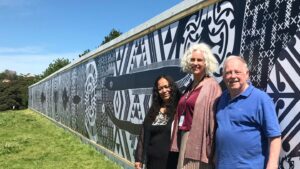20 Oct Sarjeant Gallery redevelopment wall a ‘blank canvas’ for new local artwork
 The Sarjeant Gallery redevelopment site, ringed by a 2m-high wooden wall, is being transformed into a series of artworks, thanks to renowned local artists and members of the Whanganui community.
The Sarjeant Gallery redevelopment site, ringed by a 2m-high wooden wall, is being transformed into a series of artworks, thanks to renowned local artists and members of the Whanganui community.
Sarjeant Gallery’s relationship officer Jaki Arthur said that when the redevelopment started last year they “fully expected a fence to up around the redevelopment site”, when excavation began.
“When they put up the wooden wall it wasn’t what we were expecting, we had thought it would be wire,” Arthur said.
“Everybody looked at this big white wall and went, ‘oh my god, it’s an artist’s canvas’, and that we should do something special for it.
“I was charged with getting some artworks up, and also getting up some information for the public to understand more about the redevelopment. There are also two pieces of the wall that are dedicated to artworks by the community.”
Four local artists, Cecilia Kumeroa, Simon Ormerod, Dan Mills and Mike Marsh, have designed site-specific artworks for the wall. They all 2m high and between 13m and 40m long.
The first of the artworks, “Ki uta, ki tai” by Cecilia Kumeroa, was installed on Friday, and stretches along the portion of the wall that overlooks Bell St.
“I’m feeling very satisfied and ecstatic at the result,” Kumeroa said, after seeing the installation for the first time.
“This piece is site-specific, so I took into consideration where it was going and put some elements of Māori design into it that the history.
“We have a lot of Māori designs for this area, so I tried to remake and reuse them in a way that was contemporary. I did a lot of research into the area as well, because I wanted to put in some of the flora and fauna.
“I was thinking of a silhouette style, so that we could have a really bold thing but be quite detailed as well.”
“It’s a real privilege to be a part of this.”
Mike Marsh’s artwork, “S for Sarjeant” will run along the southern wall of the Sarjeant redevelopment. Photo / Lewis Gardner
Kumeroa’s piece uses niho-taniwha (to convey attributes of bravery, determination, strength, perseverance, tenacity), as well as designs associated with protection,
abundance, achievement, cultivation, innovation, balance, proliferation of ideas and life.
The last panel (featuring the white Ruru with Tūmango design) is named “Nga hau e wha” or “the four winds”, for the location of the Sarjeant Gallery building atop Pukenamu,
“a historic fighting pā and a special site of significance for our local Whanganui tribes”.
The artists involved in the project were supported by Whanganui Community Charitable Trust, which contributed to their fees.
Trust spokesperson Ken Hird said Kumeroa’s artwork was “absolutely marvellous”.
Although it wasn’t “immediately obvious”, each of the featured designs would feature “little bits about the Sarjeant in them”, Arthur said.
“Two large bits of the wall will be covered by boards that have been painted by anyone who wants to do it. I encourage anyone who wants to put some paint down to come and get involved.”
Arthur said the Sarjeant would be providing the materials for the community part of the wall, and all the painting workshop times were on the Sarjeant’s website.
Community mural painting workshops will be held from November 8 to 21 at Sarjeant on the Quay (39 Taupo Quay). To book your place, phone (06) 349 0506 or email info@sarjeant.org.nz with name, age, contact number, and number of participants, and preferred date and time.
This article by Mike Tweed first appeared in the NZ Herald online and in the Whanganui Chronicle on 26 August 2020.

